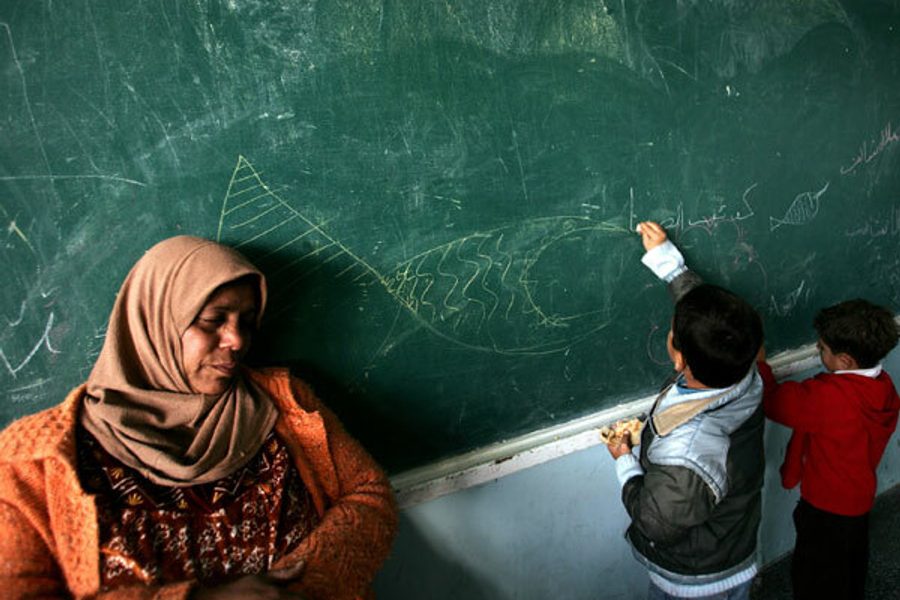
BEER-SHEVA, Israel – On Saturday, Dec. 27, the war began. The first bombardment took 3 minutes and 40 seconds. Sixty Israeli F-16 fighter jets bombed 50 sites in Gaza, killing more than 200 Palestinians, and wounding close to 1,000 more. A few hours after the deadly strike, Israeli
Prime Minister Ehud Olmert convened a press conference in Tel Aviv. With Foreign Minister Tzipi Livni sitting on his right and Defense Minister Ehud Barak on his left, Olmert declared: “It may take time, and each and every one of us must be patient so we can complete the mission.”
But what, exactly, is Israel’s mission?
Although Olmert did not say it directly, the “mission” includes four objectives.
The first is the destruction of Hamas, a totally unrealistic goal. Even though the loss of hundreds of cadres and some key leaders will no doubt hurt the organization, Hamas is a robust political movement with widespread grassroots support, and it is unlikely to surrender or capitulate to Israeli demands following a military assault. Ironically, Israel’s attempt to destroy Hamas using force has always strengthened the organization in the end, thus corroborating the notion that power produces its own vulnerability.
The second objective has to do with Israel’s Feb. 10 elections. The assault on Gaza is also being carried out to help the Kadima and Labor Parties defeat the conservative Likud and its leader Benjamin Netanyahu, who was ahead in the polls until the war began. Whether the devastation in Gaza will help Livni defeat Netanyahu or help Barak gain votes is difficult to say, but the strategy of competing with a warmonger like Netanyahu by beating the drums of war says a great deal about the three major contenders.
The third objective involves the Israeli military. After its notable humiliation in Lebanon in 2006, the Israel Defense Forces has been looking to re-establish its reputation. Last spring, it used Syria as its laboratory and now it has decided to focus on Gaza.
Finally, Hamas and Fatah have not yet reached an agreement on how to proceed when Mahmoud Abbas ends his term as president of the Palestinian National Authority on Jan. 9. One of the outcomes of this assault is that Abbas will remain in power a while longer because Hamas will be unable to mobilize supporters to force him to resign.
What is missing from this list of Israeli objectives is the attempt to halt the firing of rockets into Israel’s southern towns. Unlike the above four objectives, the government presents this one as the operation’s primary objective, which is misleading because Israel could have put an end to the rockets a long time ago.
During the six-month Israel-Hamas truce that ended Dec. 19, there was relative quiet – a quiet broken most often as a reaction to Israeli violence, such as the Nov. 4 bombing of targets in Gaza or the imposition of a total blockade that prevented basic goods, like foodstuff and medicine, from entering the Gaza Strip.
Rather than continue the truce, which would have stopped the rocket attacks, the Israeli government has again chosen to adopt strategies of violence that are akin to the ones deployed by Hamas. Only, the Israeli ones are much more lethal.
The logical fallacy
More than 90 percent of Jewish Israelis support the assault on Gaza. They say to themselves that Israel withdrew from the Gaza Strip three years ago, and that despite the withdrawal, Hamas has been shooting rockets at us. This explanation seems logical, yet it elides some crucial facts.
One fact is that Israel maintains sovereignty over the Gaza Strip, despite the withdrawal. Another fact is that the Palestinians have been living in a cage. Palestinians have not had access to basic foodstuff. Their electricity has been cut off, and many don’t have access to clean water.
When one forgets these facts, it is only rational to ask ‘Why are they still shooting at us?’ This is precisely what the media here has been pumping the public with. By contrast, if you look at what’s been going on in the Gaza Strip in the past three years and you see what Israel has been doing to the Palestinians, you would think that the Palestinian resistance is rational. And those are the facts missing in the Israeli and U.S. mainstream media.
Under attack
I am not speaking from an armchair. I know what it is like to be under rocket attack. For the past 10 days, my two children – Ariel, 4, and Aviv, 9 months – have been sleeping in a bomb shelter.
After being stuck for 72 hours in Beer-Sheva – located in the Negev Desert, 28 miles east of Gaza – my spouse Catherine and I decided to visit my mother, who lives north, so that our children could play outside during the weekend far away from the rockets.
Once there, I sat to watch TV with my mother, who like most Israelis is a devout news consumer. For the most part, the broadcast was more of the same images and voices of suffering Israeli Jews, along with the promulgation of a hyper-nationalist ethos. One news story, for example, followed a Jewish mother who had lost her son in Gaza about two years ago. The audience was told that the son has been a soldier and, with his brigade, had penetrated the Gaza Strip in an attempt to save the kidnapped soldier Gilad Shalit, who has been held hostage by Hamas since June 2006.
“Because members of his company did not want to hurt civilians,” the mother said, “they refrained from opening fire in every direction, which allowed Palestinian militiamen to shoot my boy.” When the interviewer asked her about the current Gaza assault, she said, “We should pound and cut them from the air and from the sea,” but added, “We should not kill civilians, only Hamas.”
The report ended with the interviewer asking the mother what she does when she misses her son, and, as the camera zoomed in on her face, she answered: “I go into his room and hug his bed, because I can no longer hug him.”
Thus, despite the ever-increasing loss of Palestinian life, Israel remains the perpetual victim in the collective self image. Indeed, the last frame with the mother looking straight into the camera leaves the average compassionate viewer – myself included – a bit choked up. Over the past few years, however, I have become a critical consumer of Israeli news. I can see how, regardless of what happens, we are presented as the moral players in this conflict. Therefore, this kind of reportage – where the huge death toll in Gaza is ignored and Jewish suffering is underscored – no longer shocks me.
What did unnerve me in the broadcast was one sentence from a reporter who covered the entry of a humanitarian aid convoy into the Gaza Strip on Jan. 2.
My mother and I – like other Israeli viewers – learned that 170 trucks supplied with basic foodstuff donated by the Turkish government entered Gaza through the Carmi crossing, on the southern part of Gaza. That the report had nothing to say about the context of this food shipment did not surprise me. Nor was I surprised that no mention was made of the fact that 80 percent of Gaza’s inhabitants are unable to support themselves and are therefore dependent on humanitarian assistance – and this figure is increasing daily. Indeed, nothing was said about the severe food crisis in Gaza, which manifests itself in shortages of flour, rice, sugar, dairy products, milk and canned foods, or about the total lack of fuel for heating houses and buildings during these cold winter months, the absence of cooking gas and the shortage of running water. The viewer has no way of knowing that the Palestinian health system is barely functioning or that some 250,000 people in central and northern Gaza are now living without any electricity at all due to the damage caused by the air strikes.
While the fact that this information was missing from the report did not surprise me, I found myself completely taken aback by the way in which the reporter justified the convoy’s entrance into Gaza. Explaining to those viewers who might be wondering why Israel allows humanitarian assistance to the other side during times of war, he declared that if a full-blown humanitarian catastrophe were to explode among the Palestinian civilian population, the international community would pressure Israel to stop the assault.
There is something cynical about how Israel explains its use of humanitarian assistance, and yet such unadulterated explanations actually help uncover an important facet of postmodern warfare. Not unlike raising animals for slaughter on a farm, the Israeli government maintains that it is providing Palestinians with assistance so that it can have a free hand in attacking them. And just as Israel provides basic foodstuff to Palestinians while it continues shooting them, it informs Palestinians – by phone, no less – that they must evacuate their homes before F-16 fighter jets begin bombing them.
One notices, then, that in addition to its remote-control, computer game-like qualities, postmodern warfare is also characterized by a bizarre new moral element. It is as if the masters of wars realized that since current wars rarely take place between two armies and are often carried out in the midst of civilian populations, a new just war theory is needed. So these masters of war gathered together philosophers and intellectuals to develop a moral theory for postmodern wars, and today, as Gaza is being destroyed, we can see quite plainly how the new theory is being transformed into praxis.
We have to say ‘no’
This praxis is scary. Israel has been bombing Gaza from the air and massacring people. As In These Times went to press, Israel had killed more than 750 Palestinians, including more than 200 children. In order to stop this madness we need two kinds of pressure: Israeli citizens must pressure the government from below, while the international community must pressure Israel from above.
As an Israeli citizen, I still believe in the importance of democracy and in the importance of the Israeli people making a decision. But at this point in history, we need help from concerned citizens in the global arena. We need American citizens to pressure the incoming administration to raise its voice against the use of violence. President Obama has a major role to play but it is unclear that he will do it without pressure from within the United States.
Obama, it is important to keep in mind, has a crucial advantage over his predecessors. Several years of political negotiations – from the 1991 Madrid conference, through Oslo, Camp David, Taba and Annapolis – alongside the publication of different initiatives – from the Geneva Initiative and the Saudi plan to the Nussaiba and Ayalon plan – have clarified what it would take to reach a peace settlement between the warring sides.
The two-state solution entails three central components:
1. Israel’s full withdrawal to the 1967 border with possible one-for-one land swaps so that ultimately the total amount of land that was occupied will be returned.
2. Jerusalem’s division according to the 1967 borders with certain land swaps to guarantee that each side has control over its own religious sites and large neighborhoods. Both these clauses entail the dismantlement of Israeli settlements and the return of the Jewish settlers to Israel.
3. The acknowledgment of the right of return of all Palestinians but with the following stipulation: While all Palestinians will be able to return to the fledgling Palestinian state, only a limited number agreed upon by the two sides will be allowed to return to Israel; those who cannot exercise this right or, alternatively, choose not to, will receive full compensation.
While the conditions that need to be satisfied in order to reach a peace agreement are well known and even though most political leaders understand that the only way to provide real security for the two peoples is by signing a comprehensive agreement, years of negotiations have produced only limited results.
The cruel irony is that the majority of Israelis and Palestinians in the region support the two-state solution but, nonetheless, the two parties cannot reach an agreement because sizable minorities in both camps reject this solution. These minorities have managed to hijack the respective political arenas and have succeeded in creating a deadlock that can only be overcome if the international community, and particularly the United States, assumes a more interventionist role.
With determination and political boldness, Obama can neutralize the rejectionist minorities and resolve this bloody conflict once and for all. I believe that he can achieve this objective if his administration adopts the following strategy:
• First, the White House needs to draft a proposal using the abovementioned guidelines.
• Second, the draft proposal should be submitted to the two sides so that each one can suggest minor alterations.
• Third, the Obama administration will have to hammer out a final proposal (that is, the Obama Plan).
Finally, this proposal should be publicized and brought to a referendum in both Israel and the Occupied Territories, with the United States and international community applying pressure by declaring that the two parties will be rewarded if they support the initiative and penalized if they do not. Thus, the majority of the people on each side, and not the local leadership or a rejectionist minority, will decide whether or not to accept the peace plan.
Obama’s political vision has engendered hope, not only in the United States, but as his appearance in Berlin and the post-election jubilations suggest, in the various populations of the world. My expectation is that he will make good on his promise for change and introduce a courageous initiative that will bring peace to Israelis and Palestinians. He has both an opportunity and a responsibility to do so.






